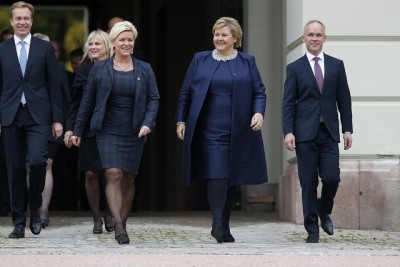Prime Minister Erna Solberg’s ministerial crew has been almost surprisingly stable since she formed Norway’s minority conservative coalition government more than two years ago. Now she’s reportedly on the verge of her first cabinet shake-up, with the timing carefully planned.

Speculation has been swirling for the past few months as to when, not if, Solberg would reshuffle her ministerial colleagues. Some commentators predicted she’d make some changes after the election in September. When that didn’t happen, speculation suggested changes after the state budget was finally agreed upon.
That didn’t happen either, at a time when the government was all but overwhelmed by the refugee crisis and economic effects of the dive in oil prices. There were many other matters commanding attention, and stability prevailed.
Newspaper Aftenposten noted recently that Solberg’s government has been among the most stable in recent Norwegian history. Former Prime Minister Jens Stoltenberg of the Labour Party started making ministerial changes just a year after winning office in the fall of 2005, when he, for example, replaced his minister for business and trade, Odd Eriksen, in September 2006. More changes came in the fall of 2007, after Stoltenberg’s government won re-election and again on November 11, 2011, when more changes followed the terrorist attacks on Norway that summer.
Stoltenberg’s predecessor as prime minister, Kjell Magne Bondevik of the Christian Democrats, opted for stability in his second government but made three changes in his first government before reaching the mid-term mark. And his predecessor, Thorbjørn Jagland of Labour, faced his first ministerial changes within months of taking over after Gro Harlem Brundtland.
Mid-term modifications
Now Solberg and her Conservative Party are midway through the first term of the government she leads, the municipal elections are behind them and it’s time to start gearing up for the next national elections in 2017. The time thus seems right for Solberg to make some personnel changes, in cooperation with her government partner, Finance Minister Siv Jensen, who heads the Progress Party.
Aftenposten reported that chatter about ministerial changes has been loudest within the Progress Party, as it rebounds in the polls after complaining that it wasn’t getting enough out of its government participation. Jensen has been under pressure to deliver more results and gain more clout. There’s been reported rumbling in the ranks to give the Progress Party’s agriculture minister, Sylvi Listhaug, a more important and higher-profile post, as if tackling Norway’s powerful farmers’ lobby wasn’t challenging enough. Listhaug may well be keen to avoid another round of subsidy negotiations this spring with farmers who never feel they get enough support. She had, at any rate, emerged as a top candidate by midday Tuesday to take over a new ministerial post that reportedly will consolidate responsibility for asylum, immigration and integration policy, clearly among the most pressing issues of the day. Norwegian Broadcasting (NRK) reported that Jon Georg Dale, a state secretary for the Progress Party in Jensen’s finance ministry, would take over for Listhaug as agriculture minister.
Jensen herself is expected to remain as Finance Minister as are other Progress Party ministers including Anders Anundsen (justice), Solveig Horne in the ministry charged with children’s and equality issues, and Ketil Solvik-Olsen (transport). Both TV2 and Aftenposten were reporting Tuesday that the party’s Robert Eriksson would be leaving his post as labour minister, though, with no successor candidates identified.
Conservatives mostly content
Most of Solberg’s own ministers looked likely to remain in their posts except for Thorhild Widvey, in charge of cultural affairs, and, surprisingly, Climate and Environment Minister Tine Sundtoft, who just returned triumphantly from Paris where she won high marks for leading crucial and successful negotiations at the UN climate summit. Norwegian Broadcasting (NRK) reported that she’s likely to be replaced by Vidar Helgesen, who has been in charge of dealing with the EU and acting as Solberg’s chief of staff.
The addition of the Progress Party’s outspoken deputy leader Per Sandberg, which set off all the ministerial speculation on Tuesday, looked likely to oust the Conservatives’ Elisabeth Aspaker as fisheries minister. She’s already been tapped to become a county governor in Northern Norway when she steps down. The futures of Oil Minister Tord Lien and Trade Minister Monica Mæland were unclear.
Solberg is expected to announce ministerial changes on Wednesday, before the Christmas holidays begin next week.
newsinenglish.no/Nina Berglund

